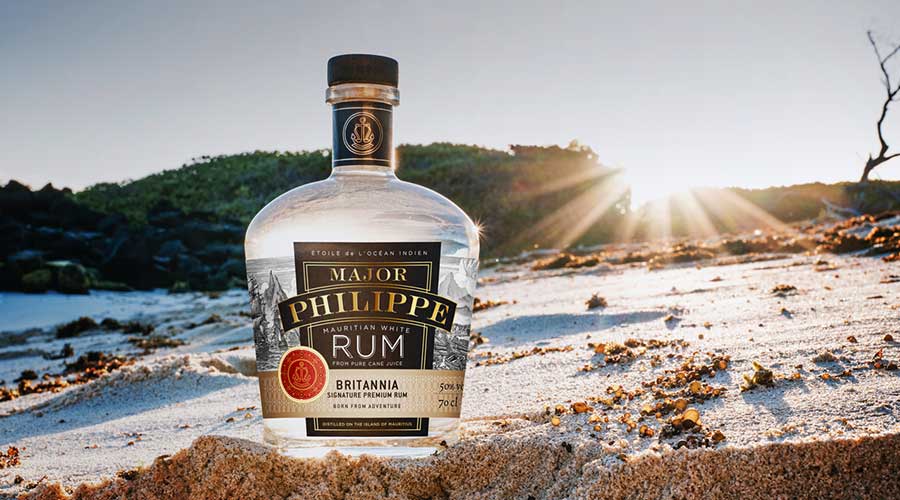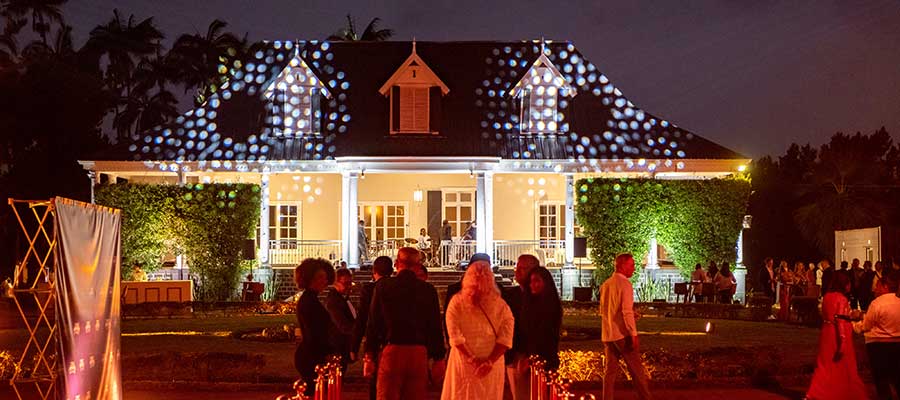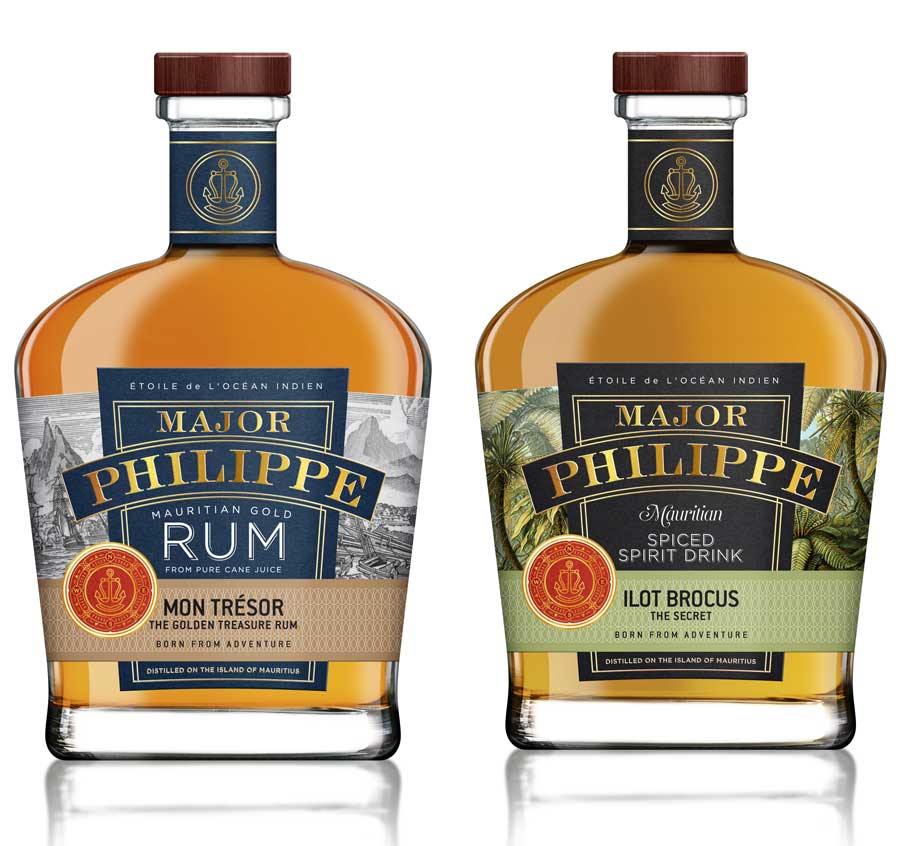Born on an island shaped by sugarcane and volcanic lava, Major Philippe marks a new chapter for Mauritian rum. Behind the venture, Omnicane Ltd. brings a century of know-how and a sustainability‑led vision to the table, aiming to place the island firmly on the international map of great rums.

A Ti-punch on a sunny beach or during a relaxed afterwork moment: a glass of rum, a few drops of lime, a pinch of sugar.
This simple, iconic cocktail sums up the Mauritian way of life, where these three ingredients come together naturally, with sugarcane at the heart of it all. Standing at the foot of Omnicane’s « sugar mountain », we have no doubt about this land’s rum-making destiny. Omnicane, a major player in Mauritian agribusiness, holds reserves that far exceed the island’s annual consumption. However, unlike other regions where molasses naturally gave rise to rum, Mauritian followed a different path for a long time.

From cane to rum: the Mauritian scenario
Located east of Madagascar, the island once benefited from a sugar agreement that guaranteed prices. Rum, even molasses-based, long remained marginal. Under British rule, an early 20th century law prohibited Mauritians from distilling below 93%.
In the early 2000s, structural reforms in the sugar sector encouraged investment and kick-started diversification of the sugar-to-bioethanol value chain. Rather than sticking to neutral alcohol, the industry gradually shifted toward characterful spirits, including higher-value rum.
With sugar prices liberalization in 2006, cane, less profitable for sugar alone, found a new horizon: rums able to win over European palates, particularly pure cane juice rums, which are now booming. Among established distilleries, such as Gray’s (1931), which has just released the island’s oldest rum, the pioneer Saint-Aubin (2003), Labourdonnais (2006), and Chamarel (2008), which emphasizes terroir, like the others, covers the full spectrum of premium vintages, the Mauritian landscape is vibrant. In this context, how did Major Philippe choose to set sail on his own adventure?
The adventure of Major Philippe
The brand pays tribute to a courageous ancestor: Philippe Guimbeau, who served during World War II and rose to the rank of major. According to Jacques M. d’Unienville, CEO of Omnicane, he was a passionate agriculturist who loved « the thrill of adventure ».

Today, this new odyssey is guided by two seasoned helmsmen: Alexander Oxenham, consultant trained in oenology in Burgundy, and Laurent Servoise, a specialist in pure cane juice rums. Their shared goal is clear: to create rums that tell the story of the island’s terroir—its cane, its climate—while developing a distinctive savoir-faire that can stand with the world’s best.
« Our idea was not to copy existing styles, but to invent a recognizable, elegant signature that remains faithful to the essence of Mauritian rum, » says Laurent. Amid cane-sweet aromas, Major Philippe’s international journey begins with a local raw material: sugarcane grown in mineral-rich volcanic soil, high in sugars and aromatics, and transformed through Omnicane’s circular production ecosystem.
Cane residues power distillation, 25 tons of CO2 are captured and repurposed daily, and by-products return to the fields as natural fertilizer. Fermentation, wrapped in aromatic vapors, relies on selected yeasts that emphasize the freshness and fruitiness of the cane juice. It lasts about 36 hours, tuned to balance intensity and finesse. Production remains calibrated to preserve quality. « We modified our column still, adding extraction points at different levels, » explains Jean-Pierre Rouillard, Head of Distillation.
« This allows us to draw, for example, an 80% molasses fraction and a 77% pure cane fraction from the fourth plate. » Alexander adds, « Unlike many very powerful or even aggressive pure cane juice rums, Major Philippe aims to be smooth and fresh. « I wanted people to feel its balance, elegance, and finesse from the very first sip. » This is the spirit of the first expression, Britannia—named after group’s historical sugar plantation—a white agricole rum where the purity of cane juice meets lively citrus notes. It’s almost irresistible neat or in a Ti-punch, ideally sipped on a terrace swept by the Mauritian breeze. Next comes Mon Trésor, aged for eight months in 84 ex-Cognac barrels of 350-liter, with a further 84 new French oak casks to be filled imminently. As its name suggests— a quiet bay in the south of the island— this rum retains the brand’s citrus freshness, layered with hints of cinnamon, a floral and complex softness.

Finally, Îlot Brocus spiced rum reflects « a century of Mauritian expertise. » Composed of 95% light rum with a touch of pure cane juice and molasses, it unfolds notes of grapefruit, passion fruit, citrus, and sweet spices, with a hint of blond tobacco. Powerful yet elegant, smooth and accessible, it can even surprise those who don’t usually enjoy spiced rum and it shines in cocktails. « This range is only the first step in a longer journey,” Laurent notes, mentioning an experimental molasses rum aged for two years in small barrels to demonstrate its aging potential. Limited editions, innovative maturations, and an expanded collection are already on the horizon. « The idea is simple: to show that Mauritian rum can be both accessible and ambitious, deeply rooted and resolutely forward-looking. »
Premium rum: a Mauritian terroir in the making
Bertrand Thevenau, Managing Director of Omnicane Retail, Brands & Property, sums it up: « It’s 100% confidence in Omnicane’s centuries-old expertise and 100% ambition to position Major Philippe on the international premium rum market. We have built this venture on our experience in energy, sugar, and ethanol, and now as a rum supplier, to take the next step with a premium brand. We will continue to move forward humbly, while contributing to the conversation around Mauritian rum’s terroir. »

As noted at the outset, the modern history of rum in Mauritius spans scarcely more than twenty years. « But the terroir expression here is shaped by the unique influence of volcanic soils on local cane varieties*, » he explains. For now, the exact contours of a distinctive flavor identity for Mauritian rum— even a future geographical indication—remain open. It is up to enthusiasts around the world to explore and reveal this character. Major Philippe now offers one more way in.
* Sugarcane varieties used : R 579, R 573, R 575, M1400/86 ET M 1176/77
